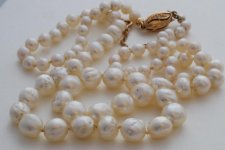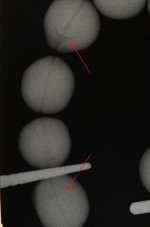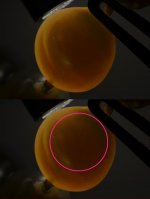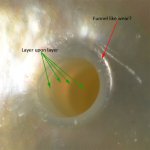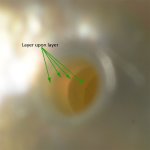You are using an out of date browser. It may not display this or other websites correctly.
You should upgrade or use an alternative browser.
You should upgrade or use an alternative browser.
Candeling of very old, supposedly cultured pearls
- Thread starter Conny Forsberg
- Start date
Happy Huku
Well-known member
Such an interesting post (and I know nothing about these things!).
Love the beautiful wrinkly yet glowing look of these pearls in daylight on white.
Love the beautiful wrinkly yet glowing look of these pearls in daylight on white.
Lagoon Island Pearls
Well-known member
- Joined
- Dec 8, 2009
- Messages
- 2,142
As you wish GemGeek, pure daylight...
Shot on acid free, pure white cardboard used for art mats.
View attachment 32733
They look much more like akoya keshi than SS keshi in this image. I agree with Pattye, these were likely restrung because considering their age and wear, the knots seem tight.
Originally the strand might have been strung without knots, but worn often, that might account for wear showing at the drill holes. Heavy gold clasp and chain from decades ago when gold was affordable.
When you go to take the pearls apart, please identify the stringing material if possible. If not silk, a burn test will be helpful.
Many thanks for the additional photos.
When you go to take the pearls apart, please identify the stringing material if possible. If not silk, a burn test will be helpful.
Many thanks for the additional photos.
CathyKeshi
Well-known member
A very interesting post and chat read ... thanks! Those pearls are very beautiful, with a lively personality 
Conny Forsberg
New Member
kelluvpearls
Consumer
Thanks for posting, this is an interesting read.
Conny, yes, likely the edge of the nucleus is what you are seeing. That is some thick nacre! It's possible some of the flattened pearls "lost" or expelled their nucleus early on then continued to build nacre in the pearl sac or they have a much smaller nucleus
You mean .50mm? That would be small!
You mean .50mm? That would be small!
Lagoon Island Pearls
Well-known member
- Joined
- Dec 8, 2009
- Messages
- 2,142
Here is an x-ray image of some of the pearls (shot by a dentist). Are the shadows at the arrows positive proof of nucleated pearls? Are we in that case supposing all pearls in the necklace are nucleated?
You have a good eye Conny. I see a symmetrical contrast in one of the unmarked pearls between the arrows too.
Early Japanese farmers used tiny beads and let them grow longer. The whole concept of large beads and thin nacre didn't come along until a few decades later.
Tiny nuclei were used in the lakes as well, right up to the time they stopped producing.
Undoubtedly, these are cultured pearls. Definitely historical, if not prototypical. An excellent example of the perils of leaving pearls too long in the grow out cycle. It's possible some have no nucleus, but were matched by surface quality and appearance.
Lagoon Island Pearls
Well-known member
- Joined
- Dec 8, 2009
- Messages
- 2,142
Conny Forsberg
New Member
I saw the one between arrowed too but had already saved the image... 
I am now dismantling the necklace and cleaning the pearls, Most have a very nice orient and luster even if they are not perfectly round it will be a nice necklace for the daughter.
Thanks for all comments and advice. I'll stick around and show you some of my other pearls.
Addendum: It is for sure silk it has been strung on. The clasp is made in Germany during 60's or 70's is my guess but the pearls are probably much older. Seems the larger pearls are more worn on the edge of the holes than the small ones.
Yes the drill holes are about 0.50 mm. Silk size 3 is tight. I keep them for restringing hanging loose on a size 1 silk.
I am now dismantling the necklace and cleaning the pearls, Most have a very nice orient and luster even if they are not perfectly round it will be a nice necklace for the daughter.
Thanks for all comments and advice. I'll stick around and show you some of my other pearls.
Addendum: It is for sure silk it has been strung on. The clasp is made in Germany during 60's or 70's is my guess but the pearls are probably much older. Seems the larger pearls are more worn on the edge of the holes than the small ones.
Yes the drill holes are about 0.50 mm. Silk size 3 is tight. I keep them for restringing hanging loose on a size 1 silk.
Last edited:
Conny Forsberg
New Member
GemGeek
Pearlista
Thanks for the daylight photo, which definitely takes away any impression of SSPs. I find myself wondering if they would be shimmering in direct daylight.
Daylight fluorescent light tends to flatten out the surface of nacre, even though the color is captured beautifully. If I can't take a daylight photo, I switch to using diffused incandescent light with an extra direct spot light to help show nacre depth and luster, especially when there is orient. I love your drill hole photos!
My main microscope has fluorescent light and it is so much easier to see because it puts out a lot more light, but I also use one with incandescent light. Some things just don't show otherwise, like pavilion flash on synthetics.
Great thread with great thoughts from everyone!
Daylight fluorescent light tends to flatten out the surface of nacre, even though the color is captured beautifully. If I can't take a daylight photo, I switch to using diffused incandescent light with an extra direct spot light to help show nacre depth and luster, especially when there is orient. I love your drill hole photos!
My main microscope has fluorescent light and it is so much easier to see because it puts out a lot more light, but I also use one with incandescent light. Some things just don't show otherwise, like pavilion flash on synthetics.
Great thread with great thoughts from everyone!
Conny Forsberg
New Member
The "funneling" is seen mostly on the bigger pearls. Maybe 30 to 35% of the total number.
Similar threads
- Replies
- 99
- Views
- 17K
- Replies
- 2
- Views
- 9K

